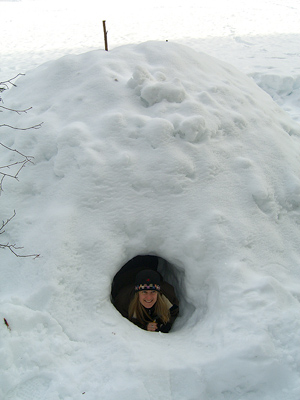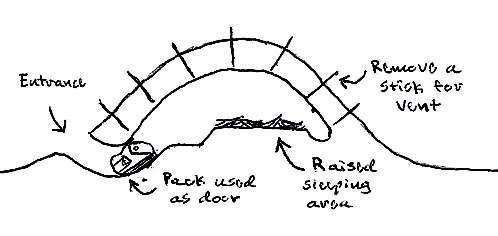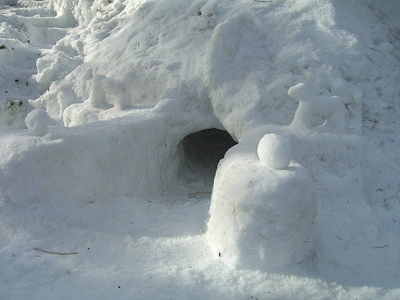Building a Quinzee

Quinzees are great group shelters to build for fun, though more importantly, they can be built in two shakes of a muskox tail to keep winter backpackers from freezing to death in a survival situation! The word "quinzee" comes from the indigenous peoples of Alaska and Northern Canada. This makes sense because these people lived their whole lives in snow.
The materials required for building this kind of snow shelter are few but important. Winter clothing is an obvious requirement. You will also need a snow shovel or a sturdy snowshoe for piling up the snow. When the quinzee construction is complete, you will need a sleeping bag and a pad (vegetation, like evergreen branches, can be substituted for the pad).
Quinzee: How to Build
The first step is to make a big dome-shaped pile of snow. You want to make this pile about as high as a
tall person. The total length at the
base of the pile should be about four feet longer than the tallest person the shelter will house. Be sure that the top of the pile is domed (rounded), because a flat roof will collapse.
Once your pile is built, walk all over it to compact the snow. Then let the snow settle for at least an hour. This step is crucial because it gives the walls and ceiling structural integrity.

Step three involves shoving sticks in through the roof and walls of the shelter every couple feet. You might ask why. The sticks play a crucial role in helping mark wall and roof thickness when you dig out the center. The sticks should pierce the pile perpendicular to the snow. The length of every stick should be about 12-18 inches long (so that 12-18 inch thick walls and ceiling can be created). I have seen many snow shelter roofs collapse due to inconsistent ceiling thickness, so don't skip this important step.
Now comes the fun part. Excavation! Begin by creating the
door. It should be small - just large enough for the
largest resident’s body to squeeze through, and located on the lowest side. This allows for
minimum heat loss. Eventually you will
have to lay down on the snow in order to continue digging out the cave. When you find yourself in this position,
congratulate yourself. The door is
complete. Now it is time to excavate
upward as well as inward.
Be More Prepared For Your Next Outdoor Adventure!

Don't leave without knowing these six essential survival skills. Our free survival mini guide reveals the strategies of:
- Shelter & fire to prevent the number one cause of death
- Obtaining clean water to avoid life-threatening dehydration
- Common wild survival foods and other critical skills!

This is the most difficult part of the snow shelter excavation process because there is not enough room to kneel or sit inside. Snow might fall on your head. Keep persevering through this. Once you can sit up or kneel, the digging will become fun again.
While you excavate there are three things to keep in mind. The most important is the butt ends of those sticks you shoved in through the walls and ceiling. Do not dig beyond the ends of those sticks. The second thing to remember is the cold sink (the concept that cold air drops like water). You want to make sure the lowest spot inside the shelter is near the door. The third thing to remember is that you want a level, elevated sleeping platform. Heat rises and you want it to get trapped where you sleep. If you excavate around the platform, then you will not have to add snow later.

Smoothing out the interior of the dome and creating small trench all
around your sleeping platform will keep melting snow water from getting
you and your gear wet. Then you want to remove a couple of the sticks to
create some ventilation holes. All snow shelters must have ventilation to allow oxygen to get in and to vent out carbon dioxide. Its is very very important to maintain these ventilation holes, especially when it is actively snowing (to prevent asphyxiation).
The next thing to do is put in your sleeping pads (or vegetation mattress’) and sleeping bags.
When you are ready for bed, you want to place a backpack or jackets in the doorway to stop cold air from being drawn into the snow shelter.
A little bit of home décor never hurt a snow shelter. Carving out little alcoves for tea-light candles can add some wonderful ambiance and a little bit of heat to the shelter. A bent stick shoved into the ceiling can be used as a hook to hang up little lanterns or headlamps. And finally, some snow-scaping on the outside adds an artistic draw. Gargoyles, lions, and snowmen can add a lot to the feng shui of a snow shelter.
I hope this article can help you build a quinzee now or in the future. Good luck and stay warm!
By the way, if you enjoyed this article then you'll love our survival mini guide. You'll discover six key strategies to staying alive in the outdoors plus often-overlooked survival tips. We're currently giving away free copies here.

Additional Resources:
How to Build a Quinzee by ScoutLife
How to Build a Quinzee by the Washington Trails Association
How to Build a Quinzee Snow Cave by the Appalachian Mountain Club
Recommended Books:
How to Build an Igloo by Norbert E. Yankielun
Snow Caves by Ernest Wilkinson
Related Courses:
Wilderness Survival Courses at Alderleaf

About the Author: Steve Nicolini is an experienced permaculturist and wilderness skills instructor. He taught at Alderleaf for a number of years. Learn more about Steve Nicolini.
Return from Building a Quinzee back to Wilderness Survival Articles
Is The Essential Wilderness Survival Skills Course Right for You? Take the "Online Survival Training Readiness" Quiz
See for yourself if this eye-opening course is a good fit for you. It takes just a few minutes! Get your Survival Training Readiness Score Now!

Grow Your Outdoor Skills! Get monthly updates on new wilderness skills, upcoming courses, and special opportunities. Join the free Alderleaf eNews and as a welcome gift you'll get a copy of our Mini Survival Guide.

 The Six Keys to Survival: Get a free copy of our survival mini-guide and monthly tips!
The Six Keys to Survival: Get a free copy of our survival mini-guide and monthly tips!
Learn more